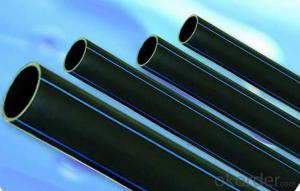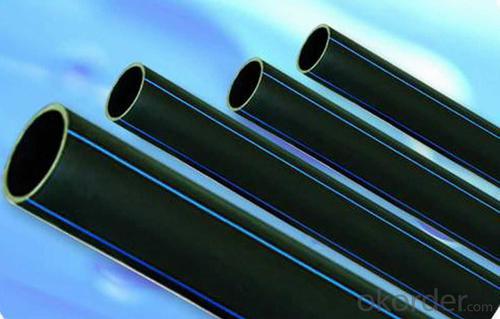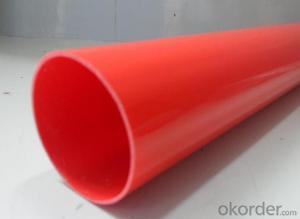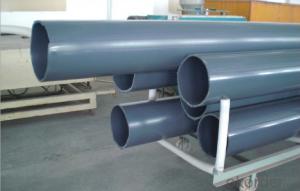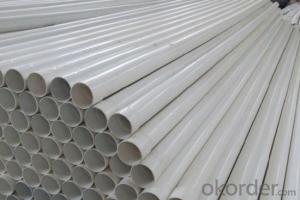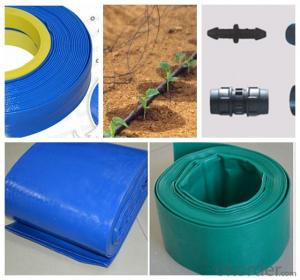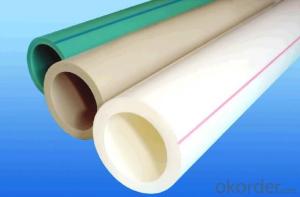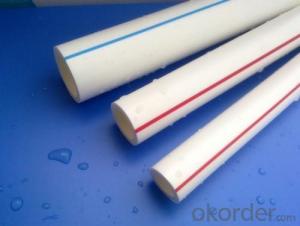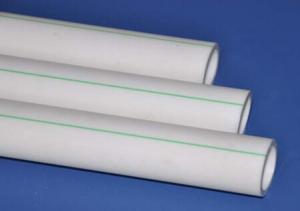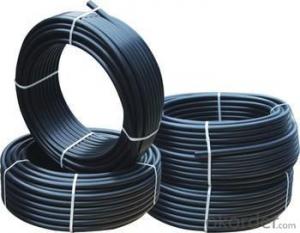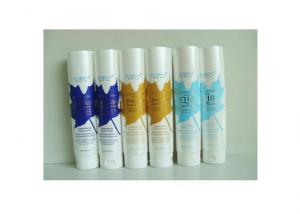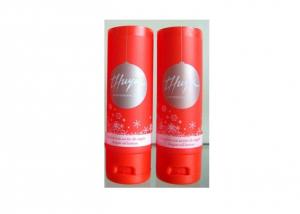Plastic Tubes HDPE Pipe ISO4427-2000
- Loading Port:
- China Main Port
- Payment Terms:
- TT OR LC
- Min Order Qty:
- -
- Supply Capability:
- -
OKorder Service Pledge
OKorder Financial Service
You Might Also Like
Physical properties[edit]
Polyethylene is a thermoplasticpolymer consisting of long hydrocarbon chains. Depending on the crystallinity and molecular weight, a melting point and glass transition may or may not be observable. The temperature at which these occur varies strongly with the type of polyethylene. For common commercial grades of medium- and high-density polyethylene the melting point is typically in the range 120 to 180 °C (248 to 356 °F). The melting point for average, commercial, low-density polyethylene is typically 105 to 115 °C (221 to 239 °F).it is transprant.
Chemical properties[edit]
Most LDPE, MDPE and HDPE grades have excellent chemical resistance, meaning that it is not attacked by strong acids or strong bases. It is also resistant to gentle oxidants and reducing agents. Polyethylene burns slowly with a blue flame having a yellow tip and gives off an odour of paraffin. The material continues burning on removal of the flame source and produces a drip.[3] Crystalline samples do not dissolve at room temperature. Polyethylene (other than cross-linked polyethylene) usually can be dissolved at elevated temperatures in aromatic hydrocarbons such as toluene or xylene, or in chlorinated solvents such as trichloroethane or trichlorobenzene.[4]
GB/T13663-2000:
| PE63管材规格 | |||||
| 公称 外径dn,mm | SDR33 | SDR26 | SDR17.6 | SDR13.6 | SDR11 |
| 公称压力 PN,Mpa | |||||
| 0.32 | 0.4 | 0.6 | 0.8 | 1.0 | |
| 公称 壁厚 | 公称 壁厚 | 公称 壁厚 | 公称 壁厚 | 公称 壁厚 | |
| 16 | 2.3 | ||||
| 20 | 2.3 | 2.3 | |||
| 25 | 2.3 | 2.3 | 2.3 | ||
| 32 | 2.3 | 2.4 | 2.9 | ||
| 40 | 2.3 | 2.3 | 3.0 | 3.7 | |
| 50 | 2.3 | 2.9 | 3.7 | 4.6 | |
| 63 | 2.3 | 2.5 | 3.6 | 4.7 | 5.8 |
| 75 | 2.3 | 2.9 | 4.3 | 5.6 | 6.8 |
| 90 | 2.8 | 3.5 | 5.1 | 6.7 | 8.2 |
| 110 | 3.4 | 4.2 | 6.3 | 8.1 | 10.0 |
| 125 | 3.9 | 4.8 | 7.1 | 9.2 | 11.4 |
| 140 | 4.3 | 5.4 | 8.0 | 10.3 | 12.7 |
| 160 | 4.9 | 6.2 | 9.1 | 11.8 | 14.6 |
| 180 | 5.5 | 6.9 | 10.2 | 13.3 | 16.4 |
| 200 | 6.2 | 7.7 | 11.4 | 14.7 | 18.2 |
| 225 | 6.9 | 8.6 | 12.8 | 16.6 | 20.5 |
| 250 | 7.7 | 9.6 | 14.2 | 18.4 | 22.7 |
| 280 | 8.6 | 10.7 | 15.9 | 20.6 | 25.4 |
| 315 | 9.7 | 12.1 | 17.9 | 23.2 | 28.6 |
| 355 | 10.9 | 13.6 | 20.1 | 26.1 | 32.2 |
| 400 | 12.3 | 15.3 | 22.7 | 29.4 | 36.3 |
| 450 | 13.8 | 17.2 | 25.5 | 33.1 | 40.9 |
| 500 | 15.3 | 19.1 | 28.3 | 36.8 | 45.4 |
| 560 | 17.2 | 21.4 | 31.7 | 41.2 | 50.8 |
| 630 | 19.3 | 24.1 | 35.7 | 46.3 | 57.2 |
- Q: Reinforced plastic pipe is high density polyethylene PE pipe to enhance it
- Such as nano materials reinforced, glass fiber reinforced, there are metal skeleton reinforcement, fiber fabric reinforcement and so on, this depends on the specific product is what, can not be generalized.
- Q: What are the advantages of using plastic tubes?
- There are several advantages of using plastic tubes. Firstly, plastic tubes are lightweight and easy to handle, making them convenient for a variety of applications. Secondly, they are durable and resistant to corrosion, ensuring a longer lifespan compared to other materials. Additionally, plastic tubes are cost-effective and readily available, making them a cost-efficient choice for both small-scale and large-scale projects. Lastly, plastic tubes offer excellent versatility, as they can be easily molded into various shapes and sizes to suit specific requirements.
- Q: I heard I could level my mobile home by using clear plastic tubing and red drink mix. Is that possible, and if so, how?
- you want to use clear plastic tubing with red drink mix in it as a level.Be sure to put a curve in the tubing so the bubble will rise to apex.Use a cork at either end to hold mix and check the level with a level altho the extra length of the tubing will make it hard to get it right.Or you could use a long 2x4 with a level on top to achieve the same results.Make sure the 2x4 is straight.Or just set the level to the floor rails underneath the trailer and jack corners until it's level.
- Q: if possible list the items , i allready have a plastic tube to use
- if you want it sealed on the ends, use sculpy or other oven bake clays to make end pieces, tape it with electrical tape for decorations.
- Q: ...little grinding bits come in.The seal can be O.D. or I.D. and needs to slip on and off fairly easy, just like the seals in the tubes that contain the littler grinding bits Dremel makes.
- The seal can be O.D. or I.D. and needs to slip on and off fairly easy, just like the seals in the tubes that contain the littler grinding bits Dremel makes.
- Q: My little sister is worried! Please help! He already chew on a piece of paper on accident.
- hamsters chew on everything. tell her not to worry, i used to work at a pet store and iv'e never herd of a hamster dieing from chewing on plastic. although it wouldn't be bad to put a little piece of wood in there that is clean for it to chew.
- Q: Can plastic tubes be used for industrial applications?
- Yes, plastic tubes can be used for various industrial applications. These tubes are often made from durable and chemical-resistant materials such as PVC, polyethylene, or polypropylene. They are commonly utilized for transporting fluids, gases, or granular materials in industries such as manufacturing, agriculture, chemical processing, and construction. Plastic tubes offer advantages such as lightweight construction, corrosion resistance, ease of installation, and cost-effectiveness, making them suitable for a wide range of industrial applications.
- Q: Are plastic tubes suitable for hot-fill applications?
- No, plastic tubes are not suitable for hot-fill applications as they can deform or melt under high temperatures.
- Q: Can plastic tubes be used for solar panel installations?
- Yes, plastic tubes can be used for solar panel installations. They are commonly used as conduits to protect and route electrical wires from the solar panels to the electrical system. Plastic tubes are lightweight, durable, and resistant to weather elements, making them a suitable choice for outdoor solar panel installations.
- Q: How long do plastic tubes last?
- The lifespan of plastic tubes can vary depending on factors such as the type of plastic used, the quality of the tube, and its usage conditions. However, on average, plastic tubes can last anywhere from a few months to several years.
Send your message to us
Plastic Tubes HDPE Pipe ISO4427-2000
- Loading Port:
- China Main Port
- Payment Terms:
- TT OR LC
- Min Order Qty:
- -
- Supply Capability:
- -
OKorder Service Pledge
OKorder Financial Service
Similar products
Hot products
Hot Searches
Related keywords
